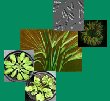| Clemens, S: Developing tools for phytoremediation: towards a molecular understanding of plant metal tolerance and accumulation, Int. J. Occup. Med. Environm. Health, 14, 235-239 (2001) | |
| Abstract: Certain plant species and genotypes are able to accumulate large quantities of heavy metals in their shoots. Based on this trait the concept of phytoremediation was developed, i.e. the use of metal hyperaccumulating plants for the cleansing of contaminated soils and water. In order to more efficiently use this capacity, an engineering of plants might be needed. However, very little is known about the underlying molecular mechanisms. Our work is focussing on the identification and characterization of plant genes involved in plant metal uptake, tolerance and accumulation. Phytochelatins are small glutathione-derived metal-binding peptides which are part of the plant metal detoxification system. Genes encoding phytochelatin synthases have been cloned and are now being studied with regard to their regulation, biochemistry and biotechnological potential. Another project aimes at the dissection of metal responses in the metallophyte Arabidopsis halleri. This plant, a close relative to the model plant Arabidopsis thaliana, is Cd hypertolerant and Zn hyperaccumulating. It grows, for instance, on medieval mining sites in the Harz mountains in Germany and in many other metal-contaminated sites in Central Europe. We have isolated metal-regulated genes from A. halleri and molecularly analyzed interesting candidate genes with regard to their function and involvement in metal accumulation and tolerance. |

Letzte Änderung 17.05.2021

